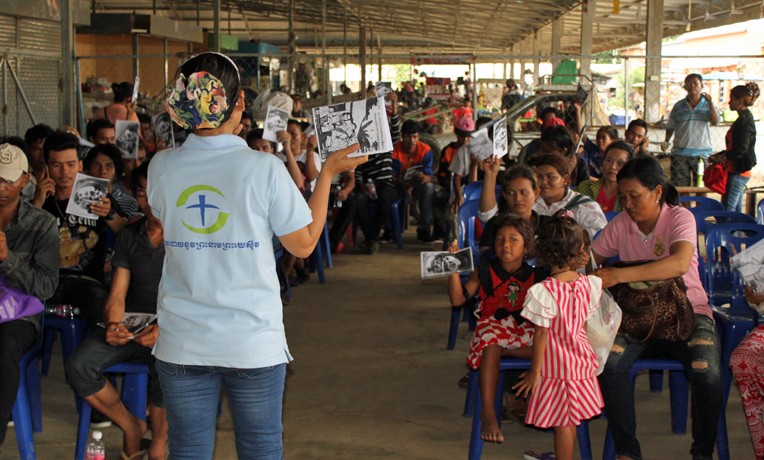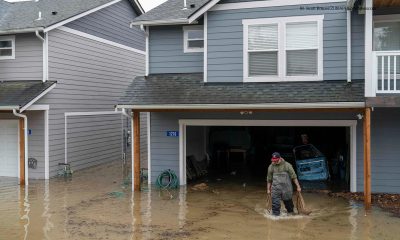Samaritan’s Purse provides information and safe passage for migrants returning home from Thailand.
I didn’t quite know what to expect at the Migrant Assistant Center. It was the last Samaritan’s Purse project I was scheduled to visit after a long week out in the field, and, to be honest, my thoughts were residing in the comforting promise of peanut butter and air conditioning waiting back at the hotel. But I climbed out of the truck and headed across a dusty parking lot to a large, open-sided shed.
The center provides a corruption-free reception area where migrants are screened for trafficking, receive assistance in returning to their home communities, and are able to access information on safe migration. Massive amounts of people—poor, hungry and exploited—return to Cambodia without the money they promised their families.

Migrants arrive at the center in Cambodia run by Samaritan’s Purse.
To my surprise, as soon as the van pulled up to the side of the chain-link fence, the unmistakable feeling of hope in the air provided an instant point of connection. Almost immediately, I could feel that this center was a life-changing place. It wasn’t only because migrants could be met and cared for in the midst of desperate circumstances, but it was also because it’s a place where the Gospel is alive.
Jesus meets his children in their most prevalent points of weakness, offers food and water, and leads them home. This is exactly what Samaritan’s Purse employees do for migrants at the center. As truckloads of migrants arrive randomly throughout the day, the process could easily become messy and chaotic. However, Samaritan’s Purse has created a seamless system for moving all the migrants through the returnee process carefully and quickly. On the afternoon of my visit, I had the privilege of witnessing this system in action.
About halfway through our tour of the large, open-air structure sitting directly on the Thai-Cambodia border, a giant metal bus arrived from Thailand, its windows fenced in with wire mesh. Anxious faces peered out, and hands clasped tightly to the wire. The migrants who were being deported from Thailand were packed so tightly in the police vehicle that I thought it might burst. I grabbed my camera, but my finger struggled to capture the reality of the situation—exhausted expressions and empty eyes.
The bus’s back door opened, and, one by one, migrants stumbled out, clearly grateful to feel the fresh air of their home country. A Samaritan’s Purse employee motioned them toward the center of the building, where rows of chairs, water, and snacks awaited. The staff began looking for people in distress while Naisoy, the center’s coordinator, spoke into a microphone. She immediately assured them that this was a free service to help them get home to their families.
A few migrants began flipping through the booklets provided on safe migration or the Gospel tract written in Khmer. Naisoy began calling out provinces, and migrants from that specific place could either buy a bus ticket or receive transportation from Samaritan’s Purse if they could not afford their own. As most of the provinces were called out loud, I wondered if these workers were excited to see their families or were discouraged by the reality of deportation. I wondered what would await them at their homes.

Samaritan’s Purse assists migrants by giving them information and transporting them home.
After the provinces had been called, some migrants remained in their chairs. These were the ones without a plan or a place to which they could return. Naisoy’s team sat down to interview these migrants, screening for trafficking and exploitation and assisting each person in determining the best way to proceed.
From the time I began snapping pictures of the back bus door opening to the last two remaining migrants sitting down for interviews, about 20 minutes had passed. That is approximately 50 people (and their luggage) exiting the bus, receiving food and water, finding a safe means of transportation home, and listening to the Gospel, all while functioning in an extremely vulnerable state. I was in awe of how efficiently the center was able to care for these people.
Naisoy told me she often receives calls in the middle of the night from families who are grateful to have their family members back. Without the center, the deportees would be susceptible to even more exploitation from taxi drivers and corrupt officials at the Cambodian border.
Migration is a prominent issue in Cambodia and will continue to be. However, Samaritan’s Purse has found a way to reach this vulnerable, exploited population by establishing a concrete area of refuge, where deportees can receive help and begin to trust again. The center not only meets immediate physical needs, but it also sends its recipients home to provinces across Cambodia with the Word of Jesus, which is more powerful than even the most expensive bus ticket.






